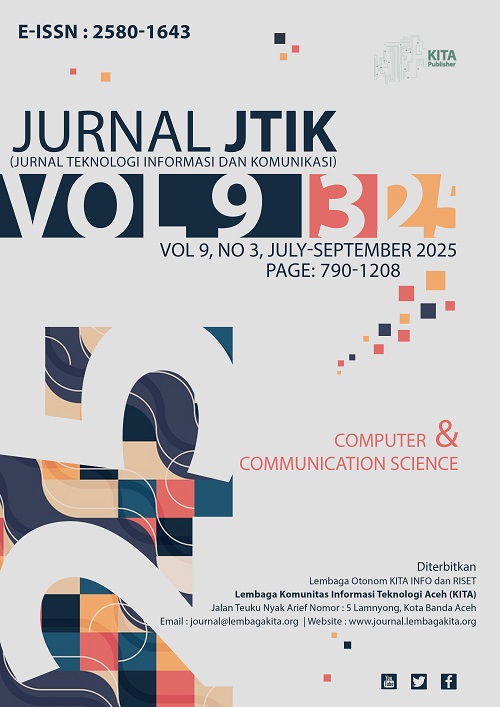Penerapan Prediksi untuk Klasifikasi Penerima Beasiswa Berprestasi pada SMK Islam Pemalang Berdasarkan Algoritma K-Nearest Neighbor
DOI:
https://doi.org/10.35870/jtik.v9i3.3848Keywords:
Predicting, Scholarship, K-Nearest Neighbor, Algorithm, ClassificationAbstract
This research aims to help Pemalang Islamic SMK in identifying outstanding students and predicting potential scholarship recipients, by utilizing the algorithm, K-Nearest Neighbor (K-NN) in determining students who have the potential to receive scholarships. This research used 100 student data involving attributes such as report card grades, academic achievement, parental responsibilities, parental salary, and participation in organizations. Meanwhile, the testing process is carried out by adding 6 data on potential scholarship recipients to be predicted. The data is then processed and normalized before being applied to the K-NN algorithm. The K-NN steps involve determining the K parameter (number of nearest neighbors), calculating the Euclidean distance, sorting the distance results, and selecting the majority category as a prediction for the new object class. The research results show that the application of the K-NN algorithm with K=3 is successful in providing predictions of outstanding students by considering relevant attributes. This process is carried out with the help of JAVA programming to calculate and analyze data. The research conclusion shows that the K-NN algorithm can be used as an effective prediction tool for classification to determine students who excel and are worthy of receiving scholarships. This research contributes to increasing efficiency and accuracy in the selection of outstanding scholarship recipients in the school environment with an accuracy of 83.33%.
Downloads
References
Miftahuddin, Y., Umaroh, S., & Karim, F. R. (2020). Perbandingan metode perhitungan jarak Euclidean, Haversine, dan Manhattan dalam penentuan posisi karyawan. Jurnal Tekno Insentif, 14(2), 69–77. https://doi.org/10.36787/jti.v14i2.270.
Nuraeni, S., Syam, S. P. A., Wajdi, M. F., Firmansyah, B., & Malkan, M. (2023). Implementasi metode K-NN untuk menentukan jurusan siswa di SMAN 02 Manokwari. G-Tech: Jurnal Teknologi Terapan, 7(1), 89–95. https://doi.org/10.33379/gtech.v7i1.1905.
Pahrudin, P., & Harianto, K. (2022). Penerapan algoritma K-Nearest Neighbor untuk klasifikasi warga penerima bantuan sosial. Building of Informatics, Technology and Science (BITS), 4(3), 1241–1245. https://doi.org/10.47065/bits.v4i3.2276.
Pratama, A., Ma’ruf, F. A., & Rinaldi, A. R. (2021). Klasifikasi Penerima Beasiswa Dengan Menggunakan Algoritma K Nearest Neighbor. Jurnal Data Science & Informatika, 1(1), 11-15.
Purwanto, A., & Nugroho, H. W. (2023). Analisa perbandingan kinerja algoritma C4.5 dan algoritma K-Nearest Neighbors untuk klasifikasi penerima beasiswa. Jurnal Teknoinfo, 17(1), 236. https://doi.org/10.33365/jti.v17i1.2370.
Tundo, T., & Mahardika, F. (2023). Fuzzy Inference System Tsukamoto–Decision Tree C 4.5 in Predicting the Amount of Roof Tile Production in Kebumen. JTAM (Jurnal Teori dan Aplikasi Matematika), 7(2), 533-544.
Tundo, T., Wijonarko, P., & Raffiudin, M. (2023). The WASPAS method in determining BSM recipients objectively. IJID (International Journal on Informatics for Development), 12(1), 338–349. https://doi.org/10.1442401/ijid.2023.4089.
Widaningsih, S. (2022). Penerapan Data Mining untuk Memprediksi Siswa Berprestasi dengan Menggunakan Algoritma K Nearest Neighbor. JATISI (Jurnal Teknik Informatika dan Sistem Informasi), 9(3), 2598-2611.
Downloads
Published
Issue
Section
License
Copyright (c) 2025 Agung Yuliyanto Nugroho, Tundo, Riolandi Akbar

This work is licensed under a Creative Commons Attribution-NonCommercial 4.0 International License.
Copyright and Licensing Agreement
Authors who publish with this journal agree to the following terms:
1. Copyright Retention and Open Access License
- Authors retain full copyright of their work
- Authors grant the journal right of first publication under the Creative Commons Attribution 4.0 International License (CC BY 4.0)
- This license allows unrestricted use, distribution, and reproduction in any medium, provided the original work is properly cited
2. Rights Granted Under CC BY 4.0
Under this license, readers are free to:
- Share — copy and redistribute the material in any medium or format
- Adapt — remix, transform, and build upon the material for any purpose, including commercial use
- No additional restrictions — the licensor cannot revoke these freedoms as long as license terms are followed
3. Attribution Requirements
All uses must include:
- Proper citation of the original work
- Link to the Creative Commons license
- Indication if changes were made to the original work
- No suggestion that the licensor endorses the user or their use
4. Additional Distribution Rights
Authors may:
- Deposit the published version in institutional repositories
- Share through academic social networks
- Include in books, monographs, or other publications
- Post on personal or institutional websites
Requirement: All additional distributions must maintain the CC BY 4.0 license and proper attribution.
5. Self-Archiving and Pre-Print Sharing
Authors are encouraged to:
- Share pre-prints and post-prints online
- Deposit in subject-specific repositories (e.g., arXiv, bioRxiv)
- Engage in scholarly communication throughout the publication process
6. Open Access Commitment
This journal provides immediate open access to all content, supporting the global exchange of knowledge without financial, legal, or technical barriers.












